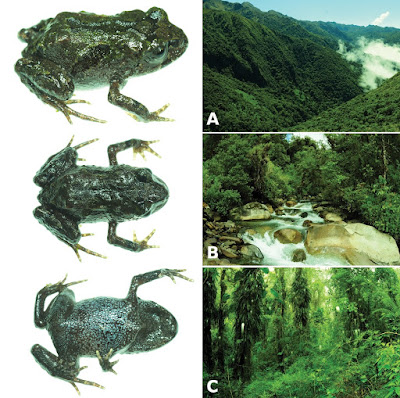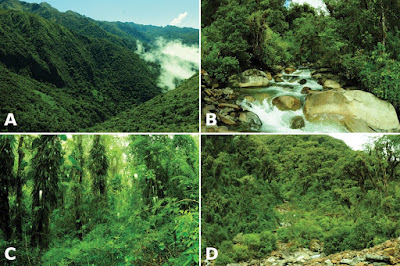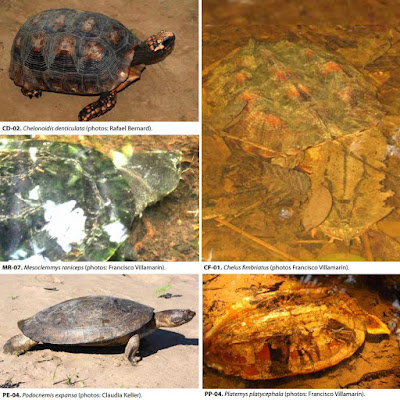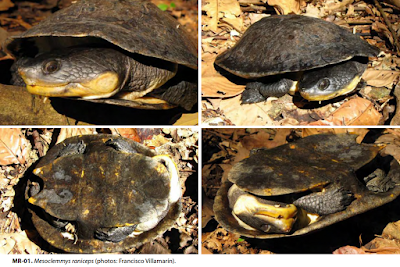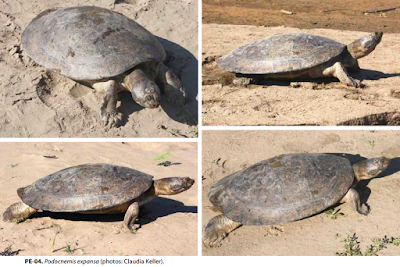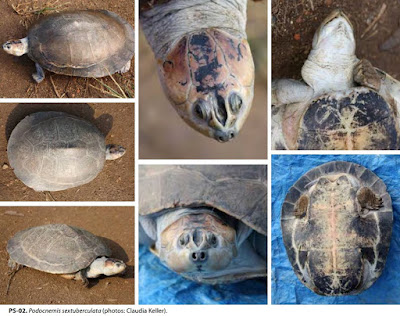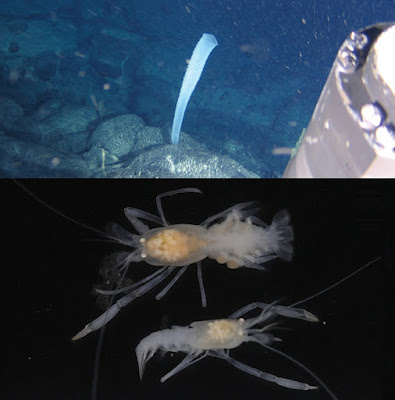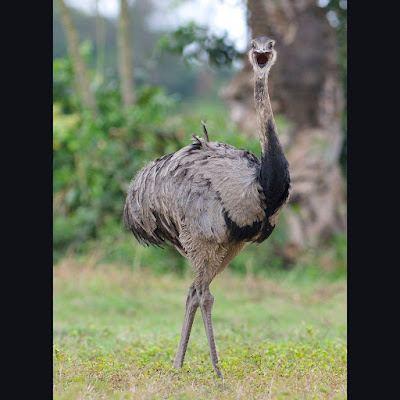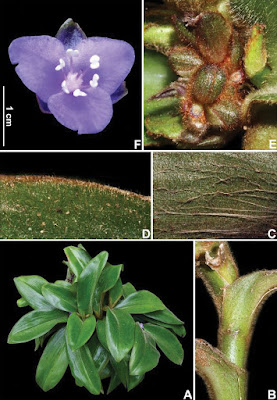Abstract
A new circumscription and a total of six microendemic species, four of them new to science, are herein presented for Siderasis, based on field and herbaria studies, and cultivated material. We provide an identification key to the species and a distribution map, description, comments, conservation assessment, and illustration for each species. Also, we present an emended key to the genera of subtribe Dichorisandrinae, and comments on the morphology and systematics of the subtribe.
Keywords: Atlantic Forest, Brazil, Commelinales, Neotropical flora, spiderwort, Tradescantieae
![]() |
Figure 1. Floral morphology of subtribe Dichorisandrinae s.l. A–C Siderasis Raf. emend M.Pell. & Faden: A S. fuscata (Lodd.) H.E.Moore B S. albofasciata M.Pell. C S. zorzanellii M.Pell. & Faden. D–L Dichorisandra J.C.Mikan: D D. acaulis Cogn. E D. hexandra (Aubl.) C.B.Clarke F D. thyrsiflora J.C.Mikan G D. paranaënsis D.Maia et al. H D. nana Aona & M.C.E.Amaral I D. incurva Mart. J D. penduliflora Kunth K D. sagittata Aona & M.C.E.Amaral L D. radicalis Nees & Mart. M Cochliostema odoratissimum Lem. N Geogenanthus rhizanthus (Ule) G.Brückn. O Plowmanianthus panamensis Faden & C.R.Hardy. Photographs A–B, D–G, J by M.O.O. Pellegrini, C by J.P.F. Zorzanelli, H by V. Bittrich, I by G.H. Shimizu, K by J.L. Costa-Lima, L by M.A.N. Coelho, M by R. Moran, N by D. Scherberich, and O by C.R. Hardy. |
Siderasis Raf., Fl. Tellur. 3: 67. 1837, emend. M.Pell. & Faden
Pyrrheima Hassk., Flora 52: 366. 1869, nom. illeg. Type species (designated here).
P. loddigesii Hassk., nom. illeg. [≡ S. fuscata (Lodd.) H.E.Moore].
Type species: Siderasis acaulis Raf. [≡ S. fuscata (Lodd.) H.E.Moore].
Etymology: Siderasis was named in allusion to the peculiar red to bright-red hairs that cover almost the entire plant, but especially the leaves. However, only S. fuscata possesses the aforementioned hairs, and all of the remaining species possess leaf blades covered by hyaline to light brown, rarely rusty hairs.
Habitat, distribution and ecology: Siderasis is endemic to the Atlantic Forest domain in coastal Brazil, occurring in the states of Bahia, Espírito Santo, and Rio de Janeiro (Fig. 2). More specifically, Siderasis is restricted to the Central Corridor of the Atlantic Forest, growing in remnants of semideciduous forests associated with inselbergs, between 90–1350 m above sea level. The genus is composed exclusively by microendemic species distributed in very small and fragmented subpopulations, susceptible to deforestation and illegal collection of specimens for ornamental purposes.
....
1. Siderasis albofasciata M.Pell., Nordic J. Bot. 35(1): 30. 2017.
Etymology: The epithet means “white-striped”, making reference to the thin and always present, white to silver stripe along the midvein of this species’ leaves.
Distribution and habitat: Siderasis albofasciata is known exclusively from the municipalities of Santa Teresa and Fundão, state of Espírito Santo (Fig. 2). It occurs in the understory of evergreen forests, in shady areas with shallow and rocky soil, with great leaf-litter accumulation.
![]() |
| Figure 7. Siderasis almeidae M.Pell. & Faden. A habit, showing a fertile rosette B detail of the elongated aerial stem, showing the rusty internodes and leaf-sheaths C detail of the lanate indumentum on the abaxial side of the leaf blade D detail of the hispid indumentum on the adaxial side of the leaf blade E detail of the inflorescence, showing the contracted cincinnus and some floral buds F front view of a flower, showing the fleshy and internally purple sepals, and the lanate ovary. Photographs A, F by M.A.N. Coelho, remaining photographs by M.O.O. Pellegrini. |
2. Siderasis almeidae M.Pell. & Faden, sp. nov.
Diagnosis: Similar to S. fuscata due to its rusty indumentum in the leaves, lilac to purple rhomboid petals and white anthers. Also, similar to S. albofasciata due to its sessile to subpetiolate leaves, blades adaxially hispid and abaxially lanate, present bracteoles, and purple filaments and style. Nevertheless, Siderasis almeidae is peculiar in lacking terminal tubers in the roots, subterraneous stems, and having aerial stems elongate and trailing in the leaf litter, leaves entirely green, fleshy showy sepals, and a densely lanate ovary.
Etymology: The epithet honors Brazilian botanist Rafael Felipe de Almeida, a prominent specialist in Malpighiaceae, contributor in the studies of Commelinaceae, husband of the first author, and co-collector of the holotype, for his unmeasurable support in the field and in my research.
Distribution and habitat: Siderasis almeidae is confined to the municipalities of Itamarajú and Prado, Bahia (Fig. 2). It occurs in the “mata higrófila” vegetation with emerging rocky formations, in shady and moist areas. In the type locality, the subpopulations were found growing in great accumulations of leaf litter, among dense clusters of Marantaceae. The area is greatly disturbed, and within private property.
3. Siderasis fuscata (Lodd.) H.E.Moore, Baileya 4: 28. 1956.
Etymology: The epithet “fuscata” means dark-colored, in allusion to the red to bright red hairs that cover almost the entire plant, in opposition to the normally hyaline hairs in most Commelinaceae.
Distribution and habitat: Siderasis fuscata is endemic to the municipalities of Rio de Janeiro (with several localities inside Floresta da Tijuca) and Niterói (with just one locality, Alto Mourão), in the Rio de Janeiro state (Fig. 2). It occurs in the vegetation on hillsides (mata de encosta) near the littoral, in shady areas with shallow and rocky soil.
![]() |
| Figure 9. Siderasis medusoidesM.Pell. & Faden. A habit, showing a fertile rosette B detail of the synflorescence, showing the elongated and tangled cincinni C front view of a flower, showing small ants near the flower center D detail of the capsule. Photographs by P. Fiaschi. |
4. Siderasis medusoides M.Pell. & Faden, sp. nov.
Diagnosis: Similar to S. almeidae due to its sessile to subpetiolate, entirely green leaves, present bracteoles, sessile flowers, purple filaments and style combined with white anthers, and oblongoid to broadly oblongoid capsules. Siderasis medusoides is distinct due to its membranous leaves, elongate and tangled cincinni, small flowers, and purple to dark blue and elliptic to narrowly obovate or spatulate petals.
Etymology: The epithet alludes to the extremely elongated cincinni, common in mature individuals of this species, due to their resemblance to the snakes that composed the hair of Medusa, one of the three Gorgon sisters from Greek mythology.
Distribution and habitat: Siderasis medusoides is known from the municipalities of Marilândia and Santa Leopoldina, in the state of Espírito Santo (Fig. 2). It grows in lowland Atlantic Forest, in shady and moist areas with great leaf litter accumulation, 90–550 m above the sea level.
5. Siderasis spectabilis M.Pell. & Faden, sp. nov.
Diagnosis: Very distinctive due to its vining habit, distichously-alternate leaves, blades asymmetric at base, main florescence a many-branched thyrse, with alternate cincinni, flowers zygomorphic, bisexual or staminate, stamens unequal, curved upwards, sigmoid filaments, and capsules globose and shallowly foveolate. It can be differentiated from S. zorzanellii by its membranous and velutine leaves, inflorescences always terminal in the secondary branches, petals dark mauve to vinaceous, rarely light pink or white, with margins ciliate with non-moniliform hairs.
Etymology: The epithet means “admirable, remarkable, spectacular”, in allusion to its distinctive growth form, small flowers with a peculiar coloration, and the unique petal margins ciliate with non-moniliform hairs.
Distribution and habitat: Siderasis spectabilis is confined to the type locality, in the native vegetation of the Horto Santos Lima (currently the headquarters of the Desengano State Park), in Santa Maria Madalena, state of Rio de Janeiro (Fig. 2). Nothing is known about this species habitat, since the original labels give no information on the area and all field expeditions to recollect this plant have been unsuccessful.
6. Siderasis zorzanellii M.Pell. & Faden, sp. nov.
Diagnosis: Similar to S. spectabilis due to its vining habit, distichously-alternate leaves, blades asymmetric at base, main florescence a many-branched thyrse, with alternate cincinni, flowers bisexual or staminate, zygomorphic, stamens unequal, curved upwards and sigmoid filaments. It can be differentiated from by its chartaceous and sparsely velutine leaves, inflorescences axillary in the primary branches or terminal in the secondary branches, and petals white with glabrous margins.
Etymology: The epithet honors the collector of the type specimens, João Paulo Fernandes Zorzanelli, Brazilian botanist and dear friend of the authors. JPFZ is an active and prominent collector in the state of Espírito Santo, with collections currently focused on Serra do Valentim, the type locality of S. zorzanellii.
Distribution and habitat: Siderasis zorzanellii is confined to the municipality of Iúna, Espírito Santo (Fig. 2). It occurs in the “Floresta Ombrófila Densa Montana” vegetation, at 1200–1350 m above the sea level, generally near disturbed sites, being less frequent in well-preserved areas. This could be related to its climbing habit and the need of more sunlight exposure then the rosette species of the genus. This pattern is common in other liana and vine groups, such as Bignoniaceae, Malpighiaceae, and Sapindaceae (Acevedo-Rodríguez, pers. comm.), especially evident in big families such as Asteraceae, where the primarily climbing genus Mikania Willd. is almost exclusively found at the edge of forests, along trails, and in disturbed areas (Oliveira 2015).
Final remarks
The present work adds four new species to Siderasis, along with the addition of new morphological characters that help clarify the circumscription of the group. Siderasis Raf. emend. M.Pell. & Faden may be uniquely characterized as comprising small perennial rosette herbs or robust perennial vines, with shoots determinate or indeterminate, leaves spirally- or distichously-alternate. The inflorescences are terminal or axillary, either a many-branched thyrse with alternate cincinni or reduced to a solitary cincinnus, cincinni always several-flowered. The flowers are chasmogamous, bisexual or male, actinomorphic or zygomorphic, and petals with glabrous margins or ciliated with non-moniliform hairs. The androecium is composed of 6 fertile stamens, filaments straight or sigmoid, anthers dorsifixed and extrorsely rimose, anther sacs semicircular, divergent, connectives expanded and quadrangular. In the gynoecium, the stigma is annular-truncate or annular-capitate, marginally papillate with unicellular papillae restricted to the margin of the stigmatic regions. Also, similar to Dichorisandra, the capsules are thick-walled, and the seeds are arillate, biseriate to partially uniseriate, with semidorsal or semilateral embryotega, and a C-shaped hilum. All species accepted by us are easily diagnosed by a unique and constant combination of morphological character states. Furthermore, each species can be easily separated based on their geographical distribution, since they are microendemics, with non-overlapping distribution areas (Fig. 2).
As indicated by several systematic studies in Commelinaceae (Evans et al. 2000, 2003; Hardy 2001; Wade et al. 2006; Zuiderveen et al. 2011; Hertweck and Pires 2014) and by the morphological evidence presented here and by Pellegrini (2017), the need to recircumscribe subtribe Dichorisandrinae is pressing. Aside from the cytological character of x=19 large chromosomes described by Jones and Jopling (1972) and hypothesized by Faden and Hunt (1991), no macro or micromorphological synapomorphies were found so far for subtribe Dichorisandrinae in its current circumscription. On the other hand, if subtribe Dichorisandrinae is recircumscribed to exclusively contain Dichorisandra and Siderasis, Dichorisandrinae s.s. can be easily morphologically characterized by its thick-walled capsules, the biseriate to partially uniseriate arillate seeds, semidorsal to semilateral embryotega, and C-shaped hilum. The lineage composed by Geogenanthus (Cochliostema+Plowmanianthus) needs to be formally recognized as a subtribe, and can be easily circumscribed by its petals with marginally fringed with moniliform hairs, and anthers sacs curved to spirally-coiled and appressed to each other. Phylogenetic studies using both nuclear and chloroplast sequences seem promising in elucidating phylogenetic incongruences in Commelinaceae (e.g. Burns et al. 2011). However, most phylogenetic in the family so far completely disregard morphological data, with the exception of Evans et al. (2000, 2003). Studies focusing on the systematics and recircumscription of Dichorisandrinae are currently being conducted, combining morphological and molecular data (Pellegrini et al., in prep.), and should shed some light on the evolution of the reproductive biology in the family.
Marco O.O. Pellegrini and Robert B. Faden. 2017. Recircumscription and Taxonomic Revision of
Siderasis, with Comments on the Systematics of Subtribe Dichorisandrinae (Commelinaceae).
PhytoKeys. 83; 1-41. DOI:
10.3897/phytokeys.83.13490






